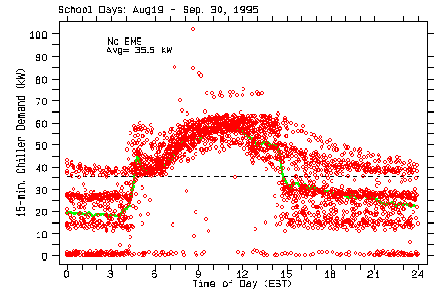
![]()
Fellsmere Elementary was representative of a typical Florida elementary school chosen for this study since it was already scheduled to have a series of retrofit measures installed. The study was limited to the original 44,241ft2 main facility. The retrofits for this particular project included a more efficient HVAC system, an energy management system (EMS),and occupancy sensor control of lighting.
The original HVAC in place consisted of both direct expansion roof-top heat pumps and a chilled water system and was fairly inefficient. The HVAC energy use was 16% of facility energy use. The original lighting was composed of a T12 lamp-magnetic ballast system. This lighting system was also fairly inefficient.
The school used an average of 64,480 kWh per month for 1994 and the average monthly demand was 248 kW.
The HVAC systems were replaced with two reciprocating chillers and one screw-type chiller. These more efficient systems reduced energy use by19% (175 kWh/day) on school days and 45% (343 kWh/day) on non-school days.The energy reduction associated with the new chiller was 27%.

Chiller load profile before installation of EMS

Chiller load profile after installation of EMS
A total of 59 occupancy sensors were installed to control the lighting system in the main building. There were 39 ceiling mounted PIR-ultrasonic hybrids used in classrooms and 20 wall-mounted sensors in offices and administrative areas. After installation and tuning, the school experienced an 8% increase in lighting energy use. Reasons for this seemingly contrary result are illustrated by a recent Wisconsin study which showed that for educational facilities with good existing manual control can find that reliance on automatic switching from occupancy sensors can increase daily lighting on-times. For example, prior to the installation, classroom lighting is typically turned off immediately upon vacancy. Even so, under motion sensor control the lights are on for a additional period equal to the time delay.Thus, only on in facilities where lights are frequently left on unintentionally,will savings be realized. However, these results should not be used to uniformly condemn the performance of occupancy sensors in educational facilities. A similar before and after experiment in another Florida school found an 11% reduction in metered lighting energy use from installing similar lighting controls.
An Energy Management System (EMS) was installed to replace the old manual HVAC controls (switches, analog thermostats, and time clocks). The net energy use reduction in cooling power due to the EMS was 17% (355 kWh/day).There was also better temperature control and more consistent scheduling of equipment with the EMS (30% or 26 kWh/day savings).
It was estimated that the total savings due to all retrofit measures was 15% (54,596 kWh) or about $2,500 annually.
- Full Publication: FSEC-CR-916:FLASTAR: Florida Alliance for Saving Taxes and Energy Resources
